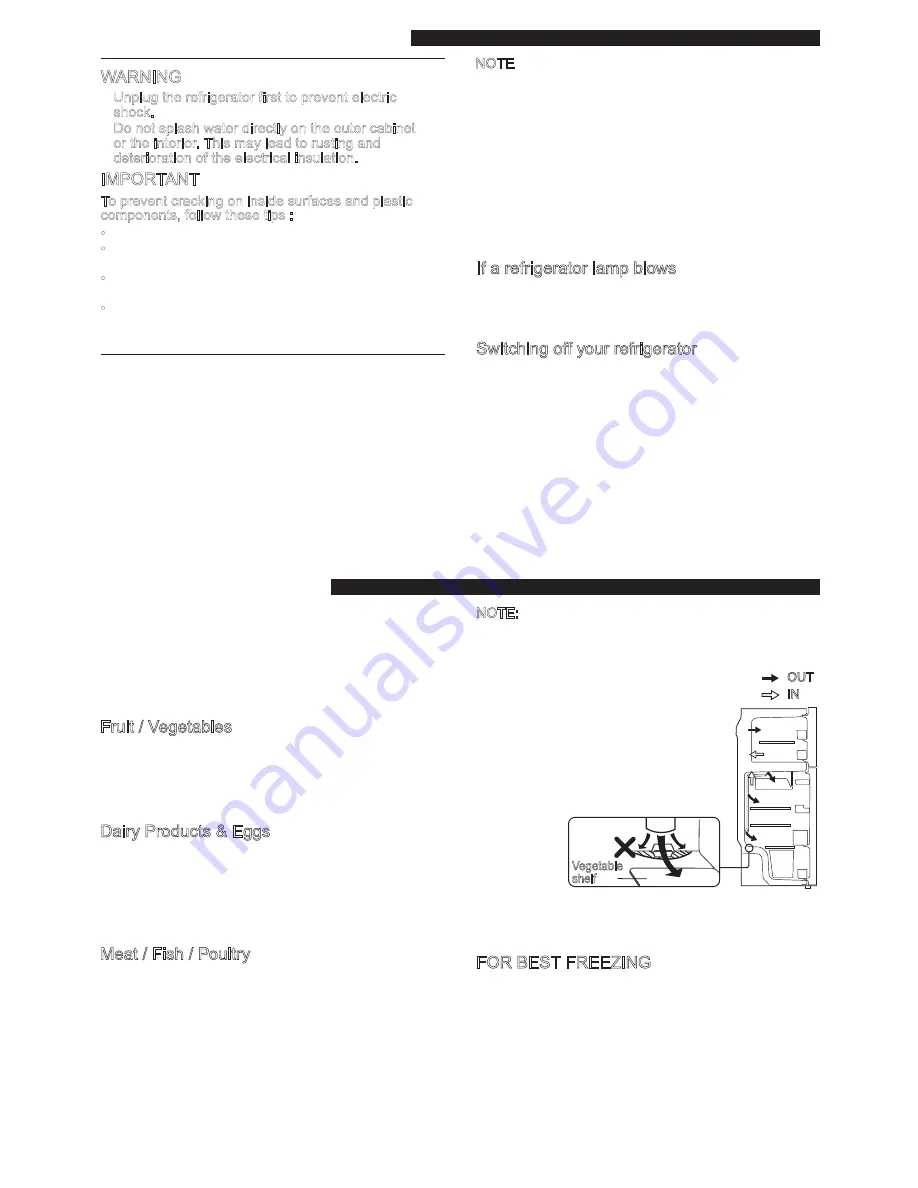
5
CARE AND CLEANING
1. Remove the shelves and pockets from the cabinet and
door. Wash them in warm soapy dishwashing water;
rinse in clean water and dry.
2. Clean the inside with a cloth soaked in warm soapy
dishwashing water. Then, use cold water to wipe off
soapy water.
3. Wipe the exterior with a soft cloth each time it is soiled.
4. Clean the magnetic door seal with a toothbrush and
warm soapy dishwashing water.
If a refrigerator lamp blows
The lamp should only be replaced by a service centre
approved by SHARP.
Switching off your refrigerator
If the refrigerator needs to be switched off for an extended
period, the following steps should be taken to reduce the
symptom of mould:
1. Remove all food.
2. Remove the power plug from the power point.
3. Clean and dry the interior thoroughly.
4. Ensure that all the doors are wedged open slightly for
air circulation.
STORING FOOD
Refrigeration reduces the rate of food spoilage.
To maximise the shelf life of perishable food products,
ensure that the food is of the freshest possible quality.
The following is a general guide to help promote longer
food storage.
Fruit / Vegetables
To minimise moisture loss, fruit and vegetables should be
loosely enclosed in a plastic material (e.g. wrap, bags) and
placed in the vegetable crisper.
Dairy Products & Eggs
•
Most dairy products have a use by date on the outer
packaging which informs the recommended temperature
and shelf life of the product.
•
Eggs should be stored in the Egg pocket.
Meat / Fish / Poultry
•
Place on a plate or dish and cover with paper or plastic
wrap.
•
For larger cuts of meat, fish, or poultry, place to the rear
of the shelves.
•
Ensure all cooked food is wrapped securely or placed in
an airtight container.
NOTE:
•
Evenly place the food on the shelves to allow the cooling
air to circulate efficiently.
•
Hot foods should be cooled before storing.
Storing hot foods increases the temperature
in the unit and increases the risk of food
spoilage.
•
Do not block the outlet and inlet of the
cool air circulating circuit with food or
containers; otherwise the food will not
be evenly cooled throughout the
refrigerator.
•
Do not
place food
directly in
front of cold
air outlet.
This may lead to the food freezing.
FOR BEST FREEZING
•
Quality of food should be fresh.
•
Freeze small quantities of food at a time to freeze them
quickly.
•
Food should be properly stored or covered and the air
should be removed to seal tightly.
•
Evenly place the food in the freezer.
•
Label bags or containers to keep an inventory of freezing
food.
IN
OUT
Vegetable
shelf
•
Keep the door securely closed.
WARNING
■
Unplug the refrigerator first to prevent electric
shock.
■
Do not splash water directly on the outer cabinet
or the interior. This may lead to rusting and
deterioration of the electrical insulation.
IMPORTANT
To prevent cracking on inside surfaces and plastic
components, follow these tips :
•
Wipe any food oils adhered to plastic components.
•
Some household chemicals may cause damage, so use
only diluted washing-up liquid (soapy water).
•
If undiluted detergent is used or soapy water is not wiped
off thoroughly, cracking of plastic parts can result.
•
Wipe any spills from the refrigerator immediately as acid
or alkaline in the food can cause cracking and staining of
plastic parts.
NOTE
•
Do not use hot water, household cleaning powders, creams
or spray-on cleaning products, or any other cleaning
products such as mineral turpentine, methylated spirits,
thinners, petrol etc. These may damage your refrigerator
and may void any warranty.
•
If the power supply is disconnected, please wait for at least
5 minutes before re-connecting power.
•
Wipe any spills from the control knob immediately as liquid
ingress can damage the electronics.
•
Do not drop objects inside the refrigerator or strike the inner
wall. This may cause the inner surface to crack.


























